The Qualcomm Snapdragon 820 Performance Preview: Meet Kryo
by Ryan Smith & Andrei Frumusanu on December 10, 2015 11:00 AM EST- Posted in
- SoCs
- Snapdragon
- Qualcomm
- Snapdragon 820
GPU Performance
Shifting gears, let’s take a look at GPU performance. As we mentioned earlier, Qualcomm isn’t disclosing much about this GPU other than that it packs quite a bit more computational power than its predecessor and should be quite a bit faster in the process. This points to a potentially significant architectural shift, but that determination will have to wait for another time.
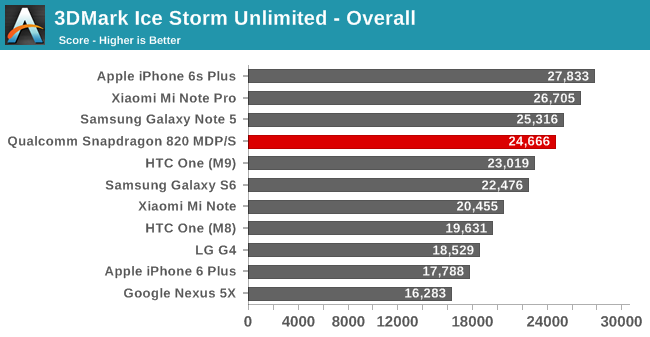
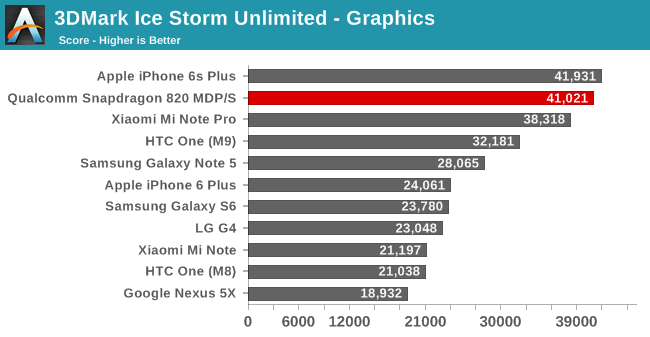
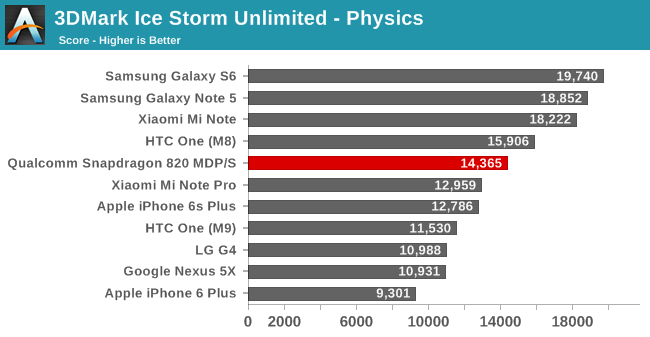
Starting with 3DMark Ice Storm Unlimited, the performance honestly doesn’t start out great. The overall score is significantly influenced by the physics score, which in turn is more concerned with the number of cores and their throughput on simple code than the ability to extract complex IPC. As a result the 4 CPU core 820 simply can’t catch up with the likes of the Samsung devices and their high-clocked big.LITTLE configurations. On the other hand the graphics score makes this the fastest Android phone to date, though relative to the 810 Mi Note Pro, perhaps not by a ton. Ultimately as this is an OpenGL ES 2.x test it’s not the most strenuous of tests these days, and comments from Qualcomm indicate that it may be a CPU-limited test on 820.
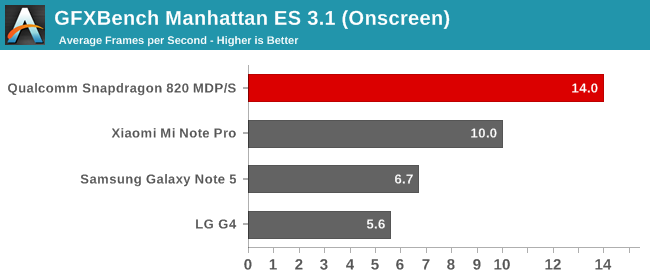
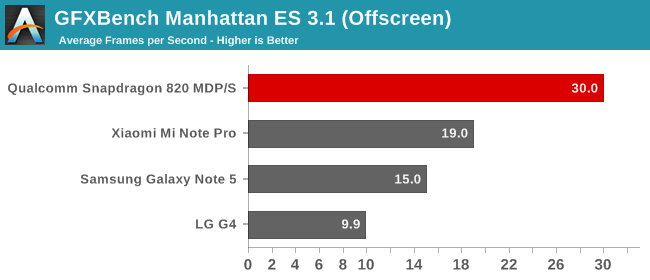
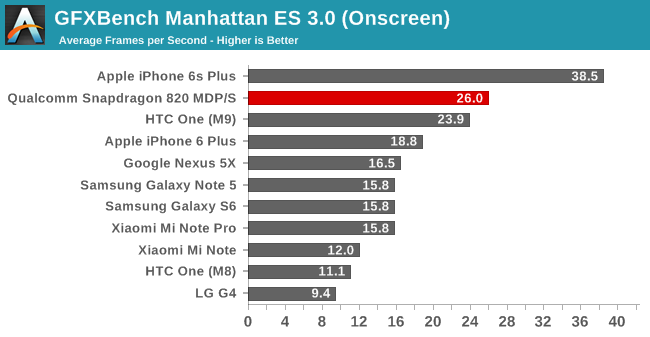
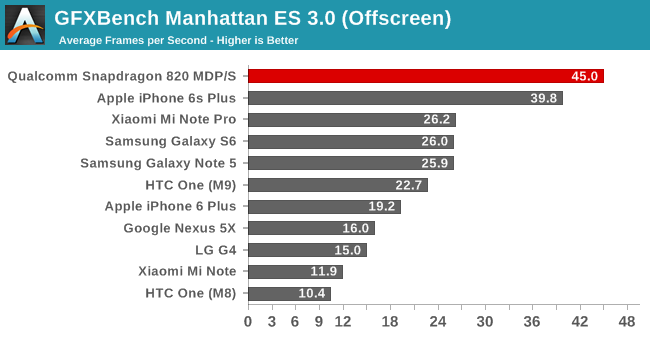
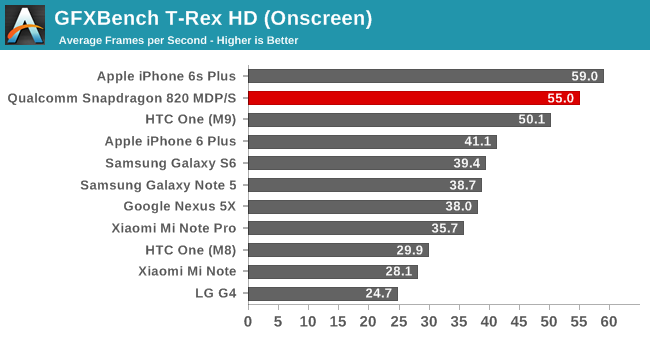
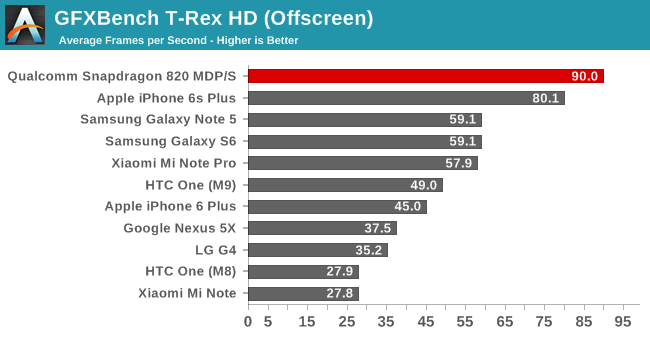
GFXBench on the other hand shows some massive gains for the 820 relative to any other Android device. In offscreen rendering mode, all 3 game tests – Manhattan ES 3.1, Manhattan ES 3.0, and T-Rex HD – put the 820 MDP/S as being 52% (or more) faster than the next-fastest Android device, either the 810 based Mi Note Pro or the Exynos 7420 based Samsung Galaxy Note 5. The single biggest jump we see is with Manhattan ES 3.0 at 72%, while the ES 3.1 version dials that back down to 52%. Even the iPhone 6s Plus, well known for its powerful GPU, is handily and consistently surpassed by the 820 here. Only due to the 6s Plus’s lower rendering resolution of 2208x1242 does it surpass the MDP/S in onscreen tests, as the latter needs to render at 2560x1600 (~50% more pixels). Qualcomm was aiming for some big GPU performance gains here and so far they are delivering.

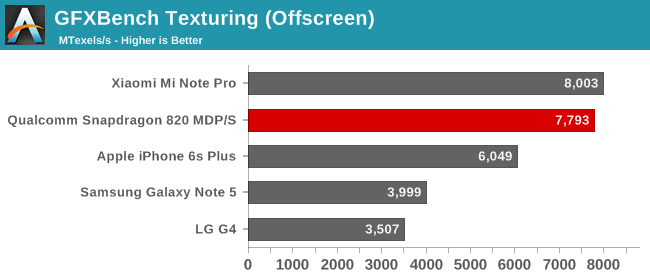
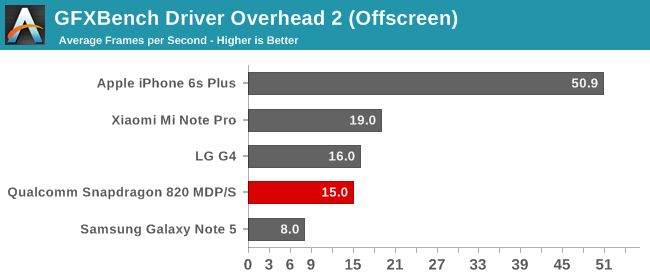
Curiously, GFXBench’s synthetic feature tests don’t show the same gains. Offscreen ALU performance is only slightly improved over the 810 (10%) or in the case of texturing is an outright regression. None-the-less full gaming performance is clearly in the 820’s favor. I’ve long suspected that the Adreno 430 GPU in the 810 had some kind of architectural bottleneck – perhaps an ALU/texture array that was difficult to fully utilize – and what we’re seeing here would back up that claim, as if that was the case then correcting it would have allowed Qualcomm to significantly boost their rendering performance while only barely changing their synthetic performance. Otherwise I find it a bit surprising that the driver overhead score is a bit worse on 820 than 810, which may be a result of the immature GPU drivers on this early device.










146 Comments
View All Comments
BurntMyBacon - Monday, December 14, 2015 - link
@V900: "Actually Samsung probably wouldn't save any money by using an Exynos SOC."They'd most likely save some. Just not enough to forgo a better chip if available.
@V900: "I doubt Apple would let them manufacture their CPUs if they weren't seperate divisions and had firewalls between them."
The "firewall" would exist around the fabrication facilities only. R&D and architecture design have no bearing on Apple products. If they are sufficiently proficient at design and the cost of the ARM IP doesn't eat the savings, then they could save some here.
@V900: "The two divisions are independent of each other, which means that Samsung the SOC vendor charges Samsung the device vendor the same prices they charge everyone else."
Current fabrication facilities (TSMC, GloFlo, et al) don't charge the same price per customer. They will give discounts for volume, customer loyalty, just to keep the fabs busy, etc.. Samsung could charge themselves preferred pricing, but it certainly wouldn't be free. How much they could save here is dependent on what they charge vs their competitors (I.E. TSMC) and if there is any margin for preferred pricing. Sometimes they will give their competitors very low margin pricing just to keep the fab busy until they have their next push. Samsung has generally been short on supply, so this hasn't happened much, but given their new expansion, it may be a consideration in the future.
zeeBomb - Thursday, December 10, 2015 - link
Damn it, late!WorldWithoutMadness - Thursday, December 10, 2015 - link
I suppose if they're gonna use Qualcomm one last time, it would be for S7 and Note6. Chances are pretty good to accommodate those who are 'stubborn' with Qualcomm's stuff.After that, they are going to use their M1 and its derivative for everything else, better margin in saturated market is their goal in the first place.
Well this wouldn't be long until Google release their own processor design to standardize Android's madness
zeeBomb - Friday, December 11, 2015 - link
So the summary is...the CPU of Kryo is getting some major competition to Apples A9 but the GPU is great, beating the A9 in many of the tests.Also... The Kyro Snapdragon 820 attained a high 131648 and the Kirin 950 with 95280. Thoughts?
http://www.gizmochina.com/2015/12/11/snapdragon-82...
gg555 - Sunday, December 20, 2015 - link
It has already been heavily leaked that the S7 will use the 820 in some markets.yeeeeman - Friday, March 13, 2020 - link
I can tell you from the future that Samsung will use both Exynos and Snapdragon for GS7. The exynos chip with custom mongoose cores is better.Krysto - Thursday, December 10, 2015 - link
Performance improvements are nice and all, and I'm more excited about the extra features such as Zeroth, Sense ID, and Smart Protect, but Qualcomm must under no circumstance blow it again on the heating/power consumption front. Whatever compromises they need to make for that to not happen again, they must do them.The Snapdragon 810 overheating issue was very much real, even with the latest versions where they claimed to have "fixed" the issue. Play any game on a 810 device for 10 minutes, and you'll see what I mean. The device get unnaturally hot. That's completely unacceptable and should never again be decided as a "compromise" in order to beat Apple in performance or whatever. Never again!
Now, I hope Qualcomm will focus even more on hardware-enabled security features. It also makes no sense for them to support SHA1 anymore, but I guess that was a decision taken years ago. Next version should drop support for it. What I'd like to see is ChaCha20 acceleration as soon as possible, as it will be part of TLS 1.3 and will be included in OpenSSL 1.1.
I also wish Qualcomm would open source more parts of its security-related firmware, and would also open source its baseband firmware (I know, a hard thing to ask but only way we can be sure there's no backdoor in there). Otherwise, at the very least they should try to completely isolate the baseband firmware from most OS functions, so even if the baseband is "owned" they can't take control of the device, other than perhaps listen to phone calls.
Security is only going to become a more and more important feature in future chips, not just for smartphones and PCs, but also for IoT, which direly needs strong security by default, because we all know most IoT OEMs will never update those devices again after people buy them, or will only do it for a short while.
ganz - Thursday, December 10, 2015 - link
I keep seeing people complaining about the heat of the 810. I've got an HTC One M9, and I've played games on it. I'd characterize the experience as, well, warm. Ish. Posts like yours indicate people are experiencing heat that's an order of magnitude greater than I am.Can you give me a sample workload that might allow me to experience this for myself? Barring that, can you give me an objective number in Celsius that's too high for you to bear?
tipoo - Thursday, December 10, 2015 - link
iirc, the M9 had a patch for the overheating issue, but that just ended up throttling performance earlier to never get so hot.
jjj - Thursday, December 10, 2015 - link
It's not about the phone heating up, it's about the chip heating up and having to slow down. The problem is not the heat to your hand, the problem is that the chip slows down hard and you lose perf.So if you want to see it overheating, track clocks and load.